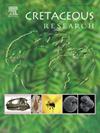Late Albian–early Turonian calcareous nannofossils from southern Tibet — Implications for preservation, biostratigraphy and palaeoecology
IF 1.7
3区 地球科学
Q1 GEOLOGY
引用次数: 0
Abstract
Marine strata of Cretaceous age are widely distributed and well exposed in the Gamba area of South Tibet. A pre-requisite for understanding the depositional and palaeoenvironmental processes, which formed these deposits, is a reliable stratigraphic framework. The strata of the Qiangdong section in the Gamba area yielded calcareous nannofossils which provide a powerful tool for establishing a detailed biostratigraphic subdivision. They also allow for supra-regional correlation, ideally on a global scale. The current study investigates the preservational state and stratigraphic significance of calcareous nannofossils from 63 samples. A total of 76 species have been identified in the 159 m thick section, allowing for the recognition of seven bioevents (calcareous nannofossil zones UC0 to UC7) covering the upper Albian–lower Turonian interval. The first occurrences of the calcareous nannofossil marker species Corollithion kennedyi (base UC1a, 100.5 Ma) and Quadrum intermedium (base UC5c, 94.1 Ma) constrain the Albian/Cenomanian and Cenomanian/Turonian boundaries in the Qiangdong section. A regional comparison with findings from the Tingri area, about 150 km west of the studied section, enhances the precision of biostratigraphic correlations in South Tibet. The findings emphasize that preservation and diagenetic influence need to be critically considered when interpreting nannofossil assemblages for palaeoenvironmental reconstructions.
藏南晚alalian -早Turonian钙质纳米化石——对保存、生物地层学和古生态学的意义
藏南甘巴地区白垩纪海相地层分布广泛,出露良好。了解形成这些矿床的沉积和古环境过程的先决条件是一个可靠的地层格架。甘巴地区强东剖面地层中发现了钙质纳米化石,为建立详细的生物地层划分提供了有力的工具。它们还允许在全球范围内进行超区域关联。本文研究了63个样品的钙质纳米化石的保存状态及其地层学意义。在159 m厚的剖面中,共鉴定出76种生物,可识别出7个生物事件(钙质纳米化石带UC0 ~ UC7),覆盖上阿尔比世—下Turonian区间。石灰质纳米化石标志种Corollithion kennedyi(碱基UC1a, 1000.5 Ma)和Quadrum intermedium(碱基UC5c, 94.1 Ma)的首次出现限制了强东剖面的阿尔比—塞诺曼尼亚和塞诺曼尼亚—Turonian界线。与研究剖面以西约150 km的定日地区对比,提高了藏南地区生物地层对比的精度。研究结果强调,在解释用于古环境重建的纳米化石组合时,需要严格考虑保存和成岩影响。
本文章由计算机程序翻译,如有差异,请以英文原文为准。
求助全文
约1分钟内获得全文
求助全文
来源期刊

Cretaceous Research
地学-地质学
CiteScore
4.10
自引率
19.00%
发文量
235
审稿时长
12 weeks
期刊介绍:
Cretaceous Research provides a forum for the rapid publication of research on all aspects of the Cretaceous Period, including its boundaries with the Jurassic and Palaeogene. Authoritative papers reporting detailed investigations of Cretaceous stratigraphy and palaeontology, studies of regional geology, and reviews of recently published books are complemented by short communications of significant new findings.
Papers submitted to Cretaceous Research should place the research in a broad context, with emphasis placed towards our better understanding of the Cretaceous, that are therefore of interest to the diverse, international readership of the journal. Full length papers that focus solely on a local theme or area will not be accepted for publication; authors of short communications are encouraged to discuss how their findings are of relevance to the Cretaceous on a broad scale.
Research Areas include:
• Regional geology
• Stratigraphy and palaeontology
• Palaeobiology
• Palaeobiogeography
• Palaeoceanography
• Palaeoclimatology
• Evolutionary Palaeoecology
• Geochronology
• Global events.
 求助内容:
求助内容: 应助结果提醒方式:
应助结果提醒方式:


